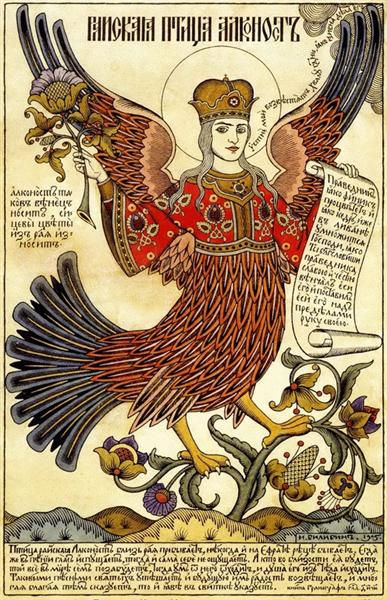Alkonost – Mythical Bird Of Paradise In Slavic And Russian Folklore
A. Sutherland - AncientPages.com - Alkonost is a sacred bird in the mythology of the Slavic people and one of the famous characters in Slavic myths and legends.
The creature has been portrayed as a beautiful bird with the head of a young maiden.
Alkonost. Russian Lubok of 18–19th Century. source
These mythical beings hypnotized people with powerful, beautiful singing and filled their hearts with love, joy, and happiness. Their perfect song had enough power to stop a war, while in another version, Alkonost's role is to torment the souls of the damned by singing terrible songs and giving them no rest.
Alkonost is believed to represent Bog Hors (Khors), the Light bird of joy in the 4-dimensional World of Yav' that surrounds us and contains people and other living beings.
Initially, Alkonost lived in the pagan Russian paradise on a mysterious island in the ocean. This island, known as Buyan, could appear and disappear using tides.
 Viktor Vasnetsov's Sirin (left) and Alkonost (right) Birds of Joy and Sorrow (1896).
Viktor Vasnetsov's Sirin (left) and Alkonost (right) Birds of Joy and Sorrow (1896).
Alkonost is sometimes mistaken for Sirin, another of the Russian folk figures, also a resident of the underground world. The two resemble each other, but Alkonost was traditionally a bird of sorrow and melancholy. However, Sirin (a bird of joy and success) is Alkonost's sister's spirit and alter ego.
A long time ago, these two beings (probably introduced by traders from Persia in the 8th or 9th century) were considered sacred birds of fortune and adored side by side as powerful protective spirits. Alkonost guards good luck by day while Sirin does it at night. In old times, entrances to cottages of Russian peasants were traditionally decorated with carved wooden images of Alkonost and Sirin.
The origin of Alkonost probably derives from Greek myths that associate Alkonost with the Greek goddess Alcyone, who was transformed into a kingfisher.
During the winter, the mythical bird lays the eggs on the seashore and then rolls them to the bottom of the sea. The sea remains calm at that time, but after seven days, when the eggs hatch, heavy storms wreak terrible havoc, and the sea becomes extremely dangerous and impossible to traverse.
Therefore, in old Slavic beliefs, people made Alkonost responsible for the climate and the weather. The creature also had the power to calm storms and even the most furious hurricanes with the sound of her song.
In some beliefs, the eggs of Alkonost have a very symbolic meaning and represent the 'Wisdom of the World of Prav' that the bird shares with people living in the world of Yav (our world).
Bird Alkonost - Ivan Bilibin (1905). Credit: Public Domain
Like other mythological birds in Slavic legends and tales, Alkonost played an essential role in Russian folklore, even after adopting Christianity in 988.
As in many places, Christianity was not immediately accepted, and various pagan ceremonies were still practiced.
The early Christian church and many missionaries ordered the destruction of all pagan idols and sacred groves. It was an attempt to erase the pagan tradition.
Eventually, Christianity was forced to accept many ancient pagan deities and mixed them with Christian symbols, including depictions of beautiful mythical creatures in the form of half-women and half-birds.
Alkonost was 'relocated' from the magical island Buyan to the Garden of Eden. She served as God's messenger, traveling to Earth to sing beautiful songs to saints, foretelling their happy future in paradise.
Under the strong influence of Christian and old pagan beliefs, Alkonost and other fabulous birds became patrons of the Slavs, who considered them divine beings with extraordinary powers or even archangels from paradise.
Today, images of divine half-birds and half-women remain in Russian folklore and the Russian Orthodox Church tradition as creatures personifying God's will.
Written by – A. Sutherland - AncientPages.com Senior Staff Writer
Updated on January 24, 2024
Copyright © AncientPages.com All rights reserved. This material may not be published, broadcast, rewritten or redistributed in whole or part without the express written permission of AncientPages.com
Expand for referencesMore From Ancient Pages
-
 Just 7% Of Our DNA Is Unique To Modern Humans – We Are Not Much Different From The Neanderthals
Archaeology | Jul 27, 2021
Just 7% Of Our DNA Is Unique To Modern Humans – We Are Not Much Different From The Neanderthals
Archaeology | Jul 27, 2021 -
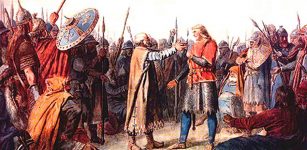 On This Day In History: Battle Of Svolder One Of Greatest Battles of Viking Scandinavia Was Fought – On Sep 9, 1000
News | Sep 9, 2016
On This Day In History: Battle Of Svolder One Of Greatest Battles of Viking Scandinavia Was Fought – On Sep 9, 1000
News | Sep 9, 2016 -
 10 Enigmatic Ancient Underwater Ruins – Our Oceans Are Full Of Secrets
Featured Stories | Aug 13, 2019
10 Enigmatic Ancient Underwater Ruins – Our Oceans Are Full Of Secrets
Featured Stories | Aug 13, 2019 -
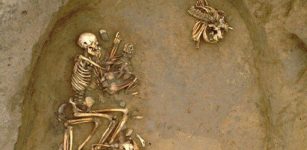 Ancient DNA Has Traced Large-Scale Migrations Into Bronze Age Britain And The Emergence of The Celtic Language
Archaeology | Dec 30, 2021
Ancient DNA Has Traced Large-Scale Migrations Into Bronze Age Britain And The Emergence of The Celtic Language
Archaeology | Dec 30, 2021 -
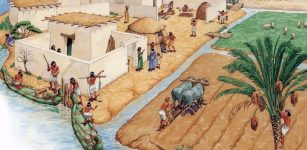 Thousand-Year-Old Farming Techniques And Irrigation Systems Can Be Used To Mitigate Climate Change
Archaeology | Mar 7, 2018
Thousand-Year-Old Farming Techniques And Irrigation Systems Can Be Used To Mitigate Climate Change
Archaeology | Mar 7, 2018 -
 Baffling Structures Unearthed In A Place Where Prehistoric Human Remains Are Missing Is An Ancient Mystery
Featured Stories | Apr 19, 2021
Baffling Structures Unearthed In A Place Where Prehistoric Human Remains Are Missing Is An Ancient Mystery
Featured Stories | Apr 19, 2021 -
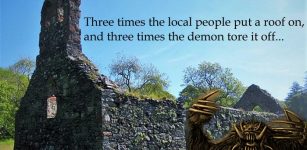 Terrifying Buggane: Demonic And Tyrannical Celtic Demon That Hated Churches And Set Them On Fire
Celtic Mythology | Jul 14, 2017
Terrifying Buggane: Demonic And Tyrannical Celtic Demon That Hated Churches And Set Them On Fire
Celtic Mythology | Jul 14, 2017 -
 Human Occupation In Lava Tube Cave In Saudi Arabia – First Evidence Discovered
Archaeology | Apr 18, 2024
Human Occupation In Lava Tube Cave In Saudi Arabia – First Evidence Discovered
Archaeology | Apr 18, 2024 -
 Mystery Of The Amazing 2,500-Year-Old Underwater Rochelongue Treasure
Featured Stories | Jul 7, 2023
Mystery Of The Amazing 2,500-Year-Old Underwater Rochelongue Treasure
Featured Stories | Jul 7, 2023 -
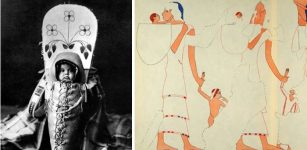 Baby Carriers Were Used 10,000 Years Ago – New Evidence
Archaeology | Sep 27, 2022
Baby Carriers Were Used 10,000 Years Ago – New Evidence
Archaeology | Sep 27, 2022 -
 Little People: Ancient Race That Pre-Dates The Celts, Anglo-Saxons And The Arrival Of Indians
Featured Stories | Nov 16, 2023
Little People: Ancient Race That Pre-Dates The Celts, Anglo-Saxons And The Arrival Of Indians
Featured Stories | Nov 16, 2023 -
 Mystery Of Lama Dashi-Dorzho Itigilov: A Mummy Whose Body Defies Time
Featured Stories | Sep 21, 2018
Mystery Of Lama Dashi-Dorzho Itigilov: A Mummy Whose Body Defies Time
Featured Stories | Sep 21, 2018 -
 Biblical Prophet Jeremiah Whose Prophecies Disappointed People
Biblical Mysteries | Jan 30, 2019
Biblical Prophet Jeremiah Whose Prophecies Disappointed People
Biblical Mysteries | Jan 30, 2019 -
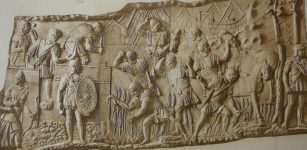 Secret Police In Ancient Rome – Frumentarii: Who Were They And What Was Their Role?
Featured Stories | Aug 12, 2019
Secret Police In Ancient Rome – Frumentarii: Who Were They And What Was Their Role?
Featured Stories | Aug 12, 2019 -
 Ancient Secrets Of Polish Ciemna Cave Inhabited By Humans 120,000 Years Ago
Featured Stories | Nov 22, 2016
Ancient Secrets Of Polish Ciemna Cave Inhabited By Humans 120,000 Years Ago
Featured Stories | Nov 22, 2016 -
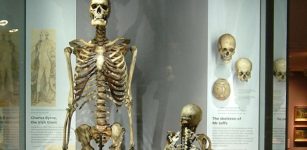 Skeleton Of Irish Giant Charles Byrne Will Not Be Displayed In The Hunterian Museum In London
Historical Figures | Jan 13, 2023
Skeleton Of Irish Giant Charles Byrne Will Not Be Displayed In The Hunterian Museum In London
Historical Figures | Jan 13, 2023 -
 Great Pyramid of Cholula Is The Largest In The World Today
Ancient History Facts | Feb 9, 2016
Great Pyramid of Cholula Is The Largest In The World Today
Ancient History Facts | Feb 9, 2016 -
 Ancient Cities Built By Biblical Giants – Archaeological Evidence
Biblical Mysteries | Jun 2, 2018
Ancient Cities Built By Biblical Giants – Archaeological Evidence
Biblical Mysteries | Jun 2, 2018 -
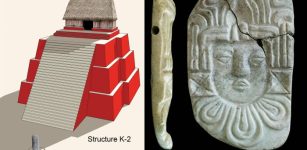 Fire-Burning Event At The Maya Kingdom Of K’anwitznal Was A Reaction To Regime Change
News | Apr 19, 2024
Fire-Burning Event At The Maya Kingdom Of K’anwitznal Was A Reaction To Regime Change
News | Apr 19, 2024 -
 Mysterious Ancient “Fish People” – Who Were They And How Did They ‘Change’ Civilizations Worldwide?
Featured Stories | Dec 20, 2021
Mysterious Ancient “Fish People” – Who Were They And How Did They ‘Change’ Civilizations Worldwide?
Featured Stories | Dec 20, 2021


